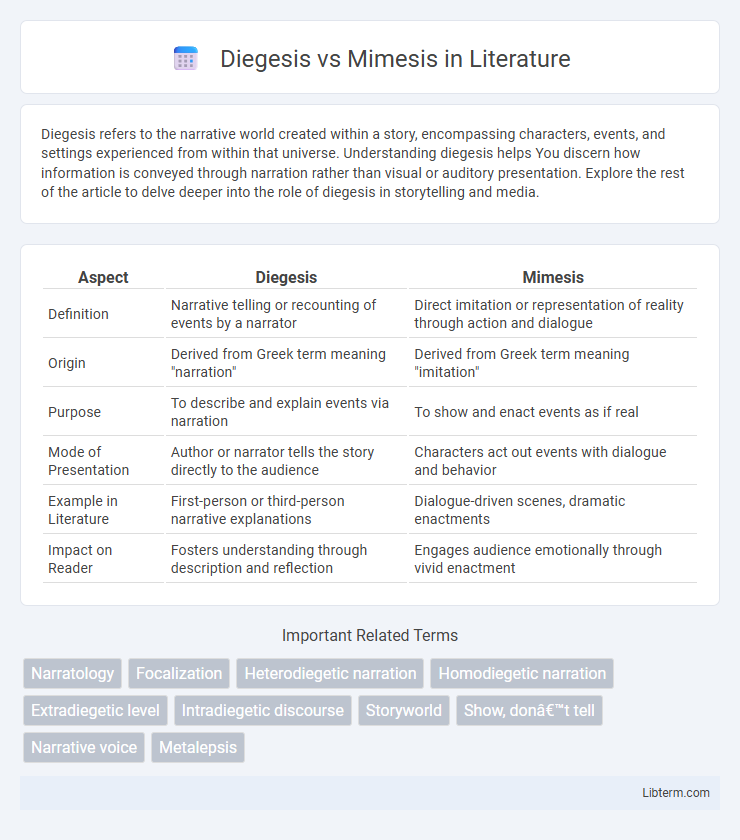Diegesis refers to the narrative world created within a story, encompassing characters, events, and settings experienced from within that universe. Understanding diegesis helps You discern how information is conveyed through narration rather than visual or auditory presentation. Explore the rest of the article to delve deeper into the role of diegesis in storytelling and media.
Table of Comparison
| Aspect | Diegesis | Mimesis |
|---|---|---|
| Definition | Narrative telling or recounting of events by a narrator | Direct imitation or representation of reality through action and dialogue |
| Origin | Derived from Greek term meaning "narration" | Derived from Greek term meaning "imitation" |
| Purpose | To describe and explain events via narration | To show and enact events as if real |
| Mode of Presentation | Author or narrator tells the story directly to the audience | Characters act out events with dialogue and behavior |
| Example in Literature | First-person or third-person narrative explanations | Dialogue-driven scenes, dramatic enactments |
| Impact on Reader | Fosters understanding through description and reflection | Engages audience emotionally through vivid enactment |
Understanding Diegesis and Mimesis
Diegesis refers to the narrative or storytelling method where events are recounted by a narrator, providing a direct explanation or summary of the story within the fictional world. Mimesis involves the direct representation or imitation of actions and experiences, allowing the audience to witness events as they unfold without mediation. Understanding diegesis and mimesis is crucial for analyzing narrative techniques in literature, film, and theater, enhancing comprehension of how stories are conveyed and experienced.
Historical Origins of Diegesis and Mimesis
Diegesis and mimesis trace their origins to ancient Greek philosophy, with Plato and Aristotle offering foundational distinctions; Plato favored mimesis as imitation while critiquing its truthfulness, whereas Aristotle in "Poetics" emphasized mimesis as a natural human propensity and defined diegesis as narrative storytelling. Diegesis historically referred to the narrator's voice recounting events, while mimesis involved dramatization or direct imitation of actions on stage. These concepts shaped classical literary and dramatic theory, influencing how stories and performances were structured and interpreted across centuries.
Diegesis: Storytelling Through Narration
Diegesis refers to storytelling through narration, where the narrator recounts events, providing insight into characters, settings, and plot developments. This narrative mode allows for direct exposition, internal thoughts, and detailed background information, creating a comprehensive understanding of the story world. Diegetic storytelling is prevalent in novels, oral storytelling, and voice-over narrations in film, emphasizing the storyteller's presence and perspective.
Mimesis: Storytelling Through Imitation
Mimesis, rooted in Aristotle's poetics, emphasizes storytelling through imitation by replicating characters' actions and emotions to create a vivid, immersive experience. This technique fosters audience engagement by presenting events as if they are happening in reality, blurring the line between fiction and lived experience. Through mimesis, narratives become dynamic reenactments that highlight human behavior, making stories more relatable and emotionally impactful.
Key Differences Between Diegesis and Mimesis
Diegesis involves narrating events through a storyteller's voice, offering a direct account of characters' actions and thoughts, while mimesis represents events through imitation or enactment, showing scenes as if they are happening in real time. Key differences include diegesis's reliance on summary and explanation, whereas mimesis emphasizes dramatic presentation and experiential immersion. Diegesis provides an external viewpoint, allowing commentary and interpretation, while mimesis presents an internal viewpoint by embodying characters' perspectives and lived experiences.
Diegesis and Mimesis in Literature
Diegesis in literature refers to the narrative mode where the story is told through an explicit narrator who describes events, characters, and settings, allowing readers to receive information directly. Mimesis, by contrast, involves the imitation or representation of real-life actions and dialogue within the text, enabling readers to experience events through characters' perspectives and interactions. The distinction between diegesis and mimesis highlights different storytelling techniques, with diegesis emphasizing narration and summary, while mimesis prioritizes dramatization and enactment.
Diegesis and Mimesis in Film and Theatre
Diegesis in film and theatre refers to the narrative world where events, characters, and dialogue exist as part of the story's reality, allowing the audience to experience the plot through a storyteller's exposition. Mimesis, contrastingly, involves the direct imitation or enactment of reality, where actors perform actions and dialogue in real-time, creating a sense of immersion without narrative commentary. The dynamic interplay between diegesis and mimesis shapes audience engagement by balancing storytelling with representational performance in cinematic and theatrical productions.
Narrative Impact: Immersion and Engagement
Diegesis involves the narrator directly conveying the story, shaping audience perception through descriptive exposition that can deepen understanding but may limit immersive experience. Mimesis, by showing actions and dialogue without overt narration, fosters stronger audience engagement and immersion by allowing viewers to experience the narrative firsthand. This contrast significantly affects the narrative impact, with diegetic storytelling prioritizing clarity and reflection, while mimetic storytelling enhances emotional involvement and vivid presence.
Modern Applications and Interpretations
Modern applications of diegesis and mimesis extend beyond classical literature into film, video games, and virtual reality, where diegetic elements build immersive worlds while mimetic techniques enhance sensory realism. In interactive media, diegetic interfaces integrate seamlessly within the narrative space, allowing players to experience story-driven environments authentically. Contemporary interpretations emphasize the interplay between showing (mimesis) and telling (diegesis) to enrich audience engagement and narrative complexity across digital storytelling platforms.
Conclusion: The Relevance of Diegesis vs Mimesis Today
Diegesis and mimesis remain pivotal concepts in contemporary storytelling, shaping narrative techniques across literature, film, and digital media. Diegesis, emphasizing narration and exposition, contrasts with mimesis's focus on direct representation and imitation of reality, influencing audience engagement and emotional impact. Modern creators strategically balance these methods to enhance immersion and thematic depth, underscoring their enduring relevance in effective communication.
Diegesis Infographic

 libterm.com
libterm.com